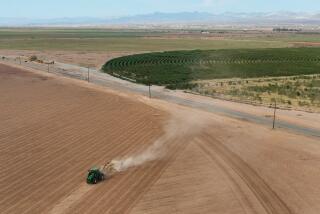Water troubles in the West may worsen
- Share via
Human-caused global warming has been shrinking the snowpack across the mountain ranges of the West for five decades, suggesting that the region’s long battle for water will only get worse, according to a computer analysis released Thursday.
As temperatures have increased, more winter precipitation has fallen as rain instead of snow, and the snow is melting sooner, according to the study published in the journal Science.
The result is that rivers are flowing faster in the spring, raising the risk of flooding, and slower in the summer, raising the risk of drought.
“These trends will only intensify over the next few decades,” said Richard Seager, a research scientist at Lamont-Doherty Earth Observatory at Columbia University, who was not part of the study.
The changes will be felt differently throughout the West, scientists said.
In Colorado, colder temperatures will probably protect the snowpack and reservoirs are large enough to store several years of water supply, said Brad Udall, a Western water expert at the University of Colorado at Boulder who was not involved in the study.
But in California, reservoirs already operate on a delicate balance.
They are kept well below capacity during the winter as protection against flooding. After the rainy season, they are filled with the spring snowmelt, storing water to be released during the dry summers.
Heavier winter rains and earlier snowmelt can overwhelm reservoirs, causing an early release of water and leaving too little for the summer.
“The handwriting is on the wall,” said lead author Tim Barnett, a marine geophysicist at Scripps Institution of Oceanography in La Jolla. “Mother Nature is going to stop being our water banker.”
Between 1950 and 1999, the period the researchers examined, the total amount of precipitation that fell in the Rockies, the Cascades, the Sierra Nevada and smaller mountain ranges across the West did not vary significantly.
But the portion arriving as snow steadily declined by an average of 4.3% per decade in the nine areas included in the study.
Average daily minimum temperatures between January and March climbed an average of 0.34 degrees Celsius per decade.
And three rivers -- the Columbia, Sacramento and Colorado -- ran higher earlier in the year. The date at which half their yearly flow had occurred was pushed up by an average of eight days each decade.
To trace the cause of the trend, the researchers used computer climate models to simulate a world with greenhouse gases held at preindustrial levels.
They factored in the known fluctuations in solar radiation and changing concentrations of volcanic dust, which reflects the sun’s heat back into space, over the second half of the 20th century.
Based on their simulations, along with historical data on snowpack, temperature and river flow, the researchers concluded that there was a less than 1% chance that the last 50 years constituted a natural aberration.
One computer model showed that rising concentrations of greenhouse gases accounted for 60% of the changes. A second analysis using another climate model calculated a contribution of 35%.
To manage the coming water changes, Udall said, the Western states must begin to adapt. Possible solutions include building more reservoirs, increasing water conservation and diverting water from agriculture to meet the increasing demand from fast-growing cities.
“There’s a dawning awareness that we’ve got a real problem with how we’ve done our planning,” Udall said.
“There’s no extra water in the system. More population means you’re going to have to find it somewhere else. And climate change means you have one more stress on an already stressed system.”
--







